Maximize Productivity: The Ultimate Guide that High Schoolers Need

Hello, I’m Aaron. As a sophomore navigating the ins and outs of high school life, one word that consistently pops up in my life is “productivity”.
Whether I’m drowning in heaps of homework or overwhelmed by endless amounts of stress, I somehow find a way to see the good side of things.
Yes, I was once a huge procrastinator. Since the COVID pandemic, I might be a strong contender for the nation’s best couch potato.
Immersing—or should I say, gluing—myself to the screen, I MIGHT or I AM on my academic downfall this year.
Hopefully, all goes well. (It probably won’t).
BUT, I’ve taken steps to somewhat combat this issue, and I want to share these tips with you guys. Although I’m only a sophomore, I believe these tips can help anyone at any point in their teenage years.
They helped me stay on track, focus on my schoolwork, and improve my productivity (though, I still struggle with procrastination from time to time).
Without further ado, let’s get started!
Set up a Calendar or Daily Routine to Follow
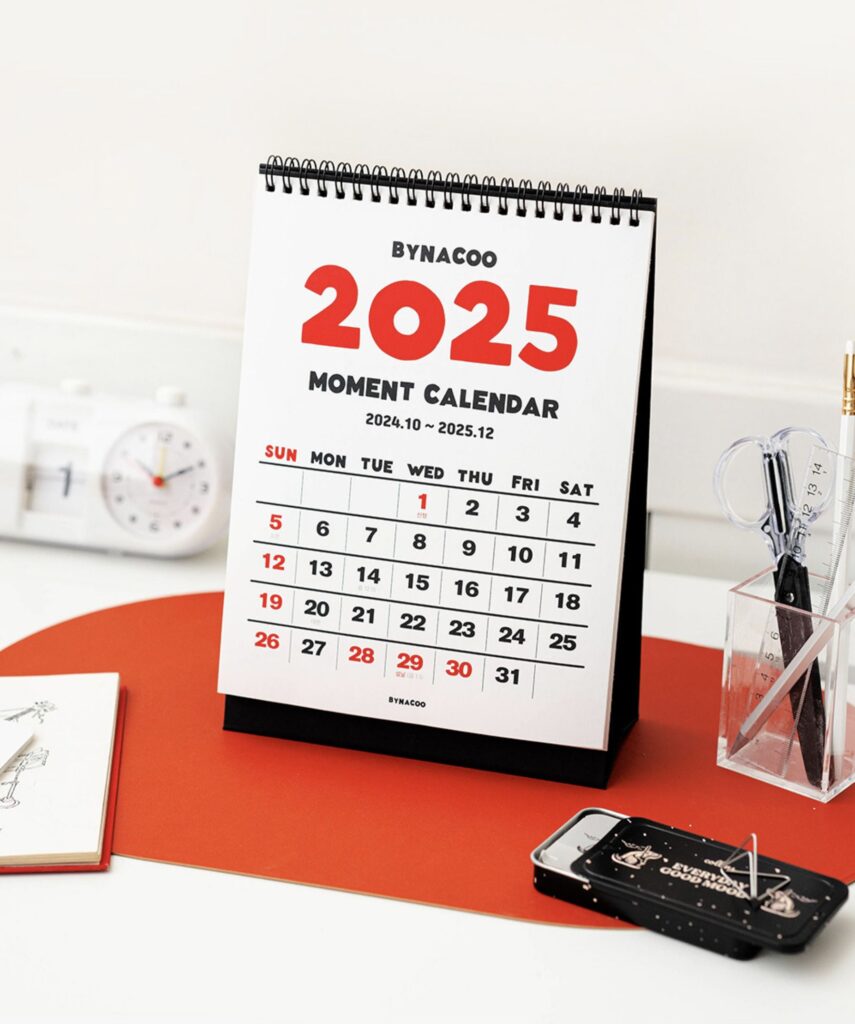
In my 2 years of high school, I have yet to see someone in my grade who doesn’t use a calendar or at least some sort of daily planner.
When you are in middle school, you could probably get away with being unorganized. Perhaps memorizing a few assignments or tasks to do throughout the day.
In high school, however, that becomes nearly impossible. For freshmen, you may be thinking that:
“Hmm, I am holding on just fine, why should I go through the hassle of starting one?”
TRUST ME.
You will need some sort of organizational calendar. Maybe in your freshman year, you felt the workload wasn’t that bad, or you could memorize every task you had to complete in the day.
Additionally, if you have never practiced using a calendar of some sort, starting early gives you the chance to learn this skill. It becomes extremely useful later in high school, college, and even in life.
It improves your organizational skills and actually improves accountability. When you plan out what to do in a day and what activities you have, it really helps ensure you stay on track and stay consistent.

Still not convinced?
Well, that’s your choice, but I STRONGLY recommend using one as it helps. Take that as you will, but yes, it WILL make your life easier.
Now you may be wondering, why?
Once you get further into high school, you realize the number of commitments you have increases exponentially.
From homework to extracurriculars, community involvement, or even sports, it starts to get out of hand, REALLY fast.
Within the first 2-3 months of high school, I was already starting to lose track of my homework assignments, chores, and my community service commitments.
That, in turn, led to me stressing over what I had to do in a day and eventually led to me doing nothing at all.
I never learned how to use a daily planner or calendar. This made it hard for me to adapt to the changes. However, I eventually kept consistent and now it’s part of my daily routine!
So, how do I make a Calendar?
While you can handwrite a daily plan or agenda, that’s quite tedious and inefficient. When you have lots of things piled up, it becomes a chore to jot everything down.
My suggestion, use Google Calendar.

Probably the most widely known tool known to every high school student (besides docs, slides, and maybe sheets), it saved many of my friends’ sanity.
Best part is, like all other Google products, it’s FREE.
I’m not going to go into detail on how to use Google Calendar, but you can check out this In-Depth Guide to Google Calendar to learn more. I will also link a video down below.
Overall, making a calendar is efficient for managing your time effectively and making sure to stay consistent with schoolwork.
Create Realistic Goals for Yourself

You’ve probably heard this a million times before, but yes, SET some goals. Whether it be for high school, college, your future career, life, etc., it definitely helps keep you on track.
Specifically for high school students, having a goal to work towards actually makes you more motivated. It helps boost your mood and helps guide you on the right path.
The key here is to set realistic goals, though. Many of my friends are crazy ambitious and are looking really far ahead into the future, but honestly, it’s better to focus on the current moment in time.
Yes, it’s good to plan, but you shouldn’t spend hours at the drawing board. As a high schooler, you really can’t predict what happens in life. Frankly, whatever you do plan probably won’t be followed.
Things change, and unexpected events might pop up and veer you off course, so it isn’t worth it to go through the hassle of planning out your life story.
What you should do however, is to take small steps and work towards a less ambitious goal. Instead of looking towards maybe 30 years into your life, try seeing yourself at the end of high school.
Don’t go all out and think you’re going to create a start-up business or get some insane job offer; focus on the current moment. Be realistic with yourself.
When I was a freshman, I had many dreams. I wanted to join many clubs, do multiple sports, and, volunteer at every community event possible. Then I reflected on my actions, why was I doing this?
I was doing so much, yet I didn’t know the purpose of the things I was doing. From that point, I began to create simple, but effective goals to keep me on track.
I dialed in on the current situation.
Instead of trying to do everything at once, I only focused on academics. I tried my hardest to bring my grades up. After that, I went to clubs. I didn’t just join every single one, I carefully picked out ones that aligned with my future career aspirations.

This was essentially my brain during the first few months of my freshman year: Absolute Madness
This helped me so much in terms of organization and increased my productivity significantly.
Before, I would spend so much time stressing about the various amounts of clubs, activities, and commitments I was involved in, but setting those goals for myself and what I needed to accomplish at the current moment gave me a general idea of the future.
This also goes hand in hand with creating a calendar or daily routine for yourself. Setting those goals helps plan out your calendar and identify what to do each day.
Like I said before, this improves accountability, which in turn boosts productivity and engagement levels.
Instead of stressing about the ludicrous number of things I HAD to do, I focused on the things I COULD do, then slowly worked up from there.
Face reality: ambition is great, but at a certain point, you need to realize what you can DO.
Have a clear goal in mind, and keep working towards that goal.
If you are a good multitasker, having multiple goals is good. However, I suggest focusing on that one goal that is most important to you.
Only Focus on Yourself. Don’t Compare Yourself with Others

Everybody has their own story.
We all come from different cultures, backgrounds, and traditions.
We all have our journey to go on. We all have different goals, aspirations, and careers.
There is one thing we have in common, though.
Everybody deserves a bright future and should actively take steps to achieve that ideal future.
What this means is to focus on yourself. Don’t try to compare your goals or your backgrounds with others.
Trust me, it doesn’t end well.
From my perspective, trying to learn about other people’s journeys is helpful, but it can cause unnecessary stress.
I am a competitive person. And when I mean “competitive,” I mean VERY, VERY competitive.
From the beginning, I always loved competing with others. I would actively go out and seek people to compare myself to.
Whether it be a school project, a personal item, or just soft skills, I needed to compare myself with something.

I wanted to be the best at everything. I always desired to be on top and sought out every single possible opportunity available for my age that would give me the edge.
This mentality had its downsides, though, the biggest one being that I NEVER thought I was good enough.
This still holds today, though maybe not as much as it did before.
From years of competing with others, I never felt proud of myself, no matter how much time or effort I put into perfecting my craft.
There would always be that lingering feeling inside me that I could do better. Someone would always be better than me. I always wanted to improve.
Whenever others beat me, I felt extremely jealous and very salty. That feeling in which I didn’t want to relinquish my position as the top contender, yet I knew I had failed.
I would have long bouts of depression when I didn’t win. I always had that feeling that I needed to go back out and prove to myself that I could be the best once again.
This caused lots of stress and prevented me from doing pretty much anything in a given day. I was spending all that time just brainstorming how to beat other people, so I didn’t get anything done.
The moral of the story is essentially to focus on yourself. Don’t worry about others. Make sure you stay true to yourself and know what your abilities are. Work towards your goals and aspirations.
Most Importantly: Don’t do something just because your friends tell you to do it. Focus on yourself and blaze your own path to success.
Take Care of Your Mental and Physical Health
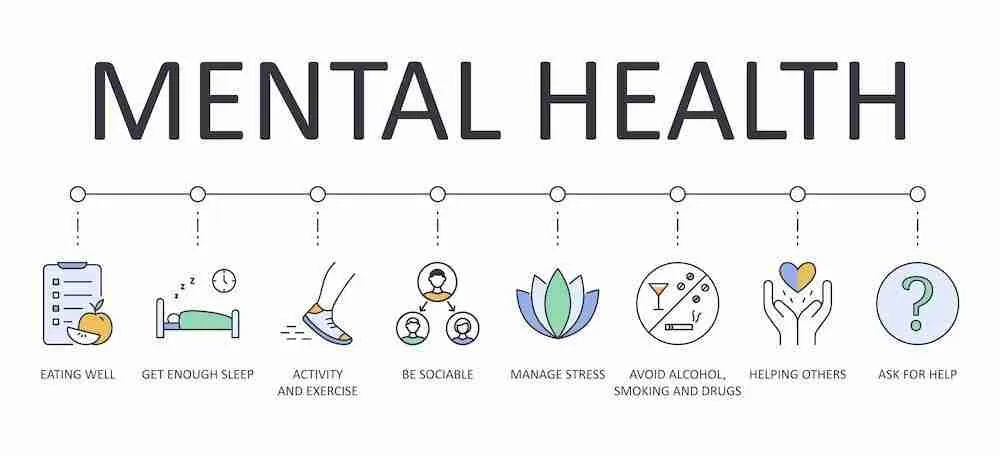
Ok. This one might seem like a no-brainer.
However, you’ll be surprised by how many high schoolers struggle with their health these days.
As you go further into high school, things start to ramp up in difficulty. Many school assignments now require more time and effort to complete.
If you’re taking any AP or IB classes, you should know what this feels like. The workload can get unbearable at times.
Maybe you felt like you wanted to quit or just forget about school altogether.
That is why it’s important to pay attention to your body and its limits, knowing when to stop.
If your body can’t function properly, how are you supposed to maximize productivity, am I right?
Well, how can I improve my health?
For starters, take some breaks.
Nobody expects you to grind homework assignments nonstop. If you’re feeling fatigued, take a break. According to Cornell Health, breaks as short as 5 minutes are shown to refresh energy levels and increase productivity.

Additionally, there are various strategies you can take advantage of. For example, the Pomodoro Method involves working for 25-minute intervals with 5-minute breaks in between each interval. This allows for optimal decision-making and gives your brain time to recoup before diving back in.
Alternatively, if you have a LOT of assignments to complete, you might want to try the University of Washington’s Technique, taking a 15-minute break for every 50-90 minute study session. This gives more study time for people who need to be extra productive during the day.
Anything Else?
Another big thing people need is energy.
I’ve mentioned it repeatedly throughout the last section, but I want to drive this point home.
As humans, we need energy to function. And how do we get that energy, you may ask?
Food.
The nutrients we get from eating power our organs, allowing them to function at their best.
So yes, EAT.

You will be shocked by the number of people who will cram so many things together and forget to replenish their body.
The next day, they will probably look like a zombie and be incredibly tired. Many of my friends would have late-night cram sessions, resulting in them pretty much sleeping on their desks the next day.
Make sure to eat a balanced diet with essential sources of protein, carbohydrates, and fats. Also, don’t forget to eat your fruits and vegetables, adding more nutrients to your meal.
Always, and I mean ALWAYS, try to eat and replenish your body’s energy. Don’t ever think that you can steamroll through a 5-hour session of pure studying without eating.
If you’re feeling hungry, make sure to take the time to fuel up! Your body will thank you later.
The MOST Important Thing to Do!
**Note: This is more of a personal opinion, feel free to disagree.
Yes, this IS the most important thing to do to improve your health.
What is it?
Socializing.
That’s right: talking to your friends and going out can improve your health and overall mood.
Before you come after me, I’m not saying that you should hang out with your friends every day and forget about your other commitments.

I think that if you have a lot on your mind, taking the time to socialize is a great idea. It allows your brain to relax and have some fun.
Being cooped up in your room isn’t very fun, and will get repetitive from time to time. Maybe hopping on a Discord call or a quick scroll through TikTok will get you back on track.
Don’t abuse this, though. Make sure you are still effectively managing your time and know when to get back to the task at hand.
Learn to Manage Time Effectively
Ok.
This skill cannot be just learned within a few weeks or so. It takes consistent practice and a strict routine to be able to drill it into your head.
Honestly speaking, this is one of the MOST IMPORTANT life skills, not just in high school.
Time management is so important for improving productivity. Knowing when to start homework or to stop playing games is such an important skill.
This also goes hand in hand with accountability. Being able to hold yourself accountable for your actions and disciplining yourself is so important. Once you get into college, nobody is going to come tell you when to study or do your chores.
I know many people have probably already told you to manage your time and to start being more independent, but how do you do that?
How to Manage Your Time to Increase Productivity
One method, like I said before, is to use a calendar.
I said it once, and I will say it again. Use Google Calendar.
It is an absolute lifesaver. Use it to plan out your day.
When you have lots of things to do, putting them all in the calendar and setting up reminders before an event helps with organizing your life.

Additionally, having specific time blocks for different activities (i.e homework) gives you an idea of how long to spend on each thing.
It reduces idle time and tells you exactly what you need to do. Say you forgot what things you have to do that day. You then proceed to check your calendar, and everything is neatly lined up, ready for you to start.
For those who find themselves with nothing to do, a calendar helps you stay proactive and productive. Maybe you have a 2-hour time slot between two activities that hasn’t been filled. You might take the time to engage in some family bonding or maybe take a stroll around the neighborhood.
According to the Columbia Business School, when people use calendars, they are more likely to follow through with their activity. It allows them to see the big picture, knowing how events will pan out and interact with each other, giving them time to plan.
Mastering Productivity with the Eisenhower Matrix

Another way to manage time effectively is to employ a technique called the Eisenhower Matrix. Named after former President Dwight D. Eisenhower himself, it outlines a framework for prioritizing tasks based on urgency and importance.
To start, compile a to-do list of every task or activity you need to complete. Then you need to decide if those tasks are urgent or important.
He defines these two words as such:
Urgency: Tasks that require immediate attention; needs to be completed ASAP; have clear consequences if not completed by a certain deadline.
Importance: Tasks that help achieve long-term goals do not require immediate attention; they require careful thought and planning to efficiently use resources.
He then splits it off by quadrants as shown here:

📌 Quadrant 1: Urgent & Important (Do it now)
These tasks require immediate action and have significant consequences if delayed. They could include:
- Studying for a test that’s tomorrow
- Completing an urgent project deadline
- Handling a last-minute team responsibility
✅ Action: Do these tasks right away to prevent crises.
📌 Quadrant 2: Important but Not Urgent (Plan it)
These are tasks that contribute to long-term success but don’t need to be done immediately. Examples:
- Preparing for college applications in advance
- Practicing CAD skills for a future competition
- Creating a study plan to avoid last-minute cramming
✅ Action: Schedule these tasks in your planner or calendar to ensure progress.
📌 Quadrant 3: Urgent but Not Important (Delegate it)
These tasks demand immediate attention, but don’t necessarily align with your priorities. They could include:
- Responding to non-essential emails or messages
- Being asked to help with something that doesn’t contribute to your goals
- Unplanned distractions from others
✅ Action: Delegate or minimize these tasks whenever possible.
📌 Quadrant 4: Not Urgent & Not Important (Eliminate it)
These activities do not contribute to productivity and should be minimized. Examples:
- Mindlessly scrolling social media
- Watching YouTube videos with no real purpose
- Procrastinating on important tasks with unnecessary busywork
✅ Action: Limit or eliminate these activities to free up time for high-impact tasks.
How to Use the Eisenhower Matrix Effectively
- List Your Tasks – Write down everything you need to do.
- Categorize Each Task – Assign each task to one of the four quadrants.
- Take Action Accordingly – Focus on Quadrants 1 & 2, delegate Quadrant 3, and reduce Quadrant 4.
- Review & Adjust – Regularly update your priorities to stay on track.
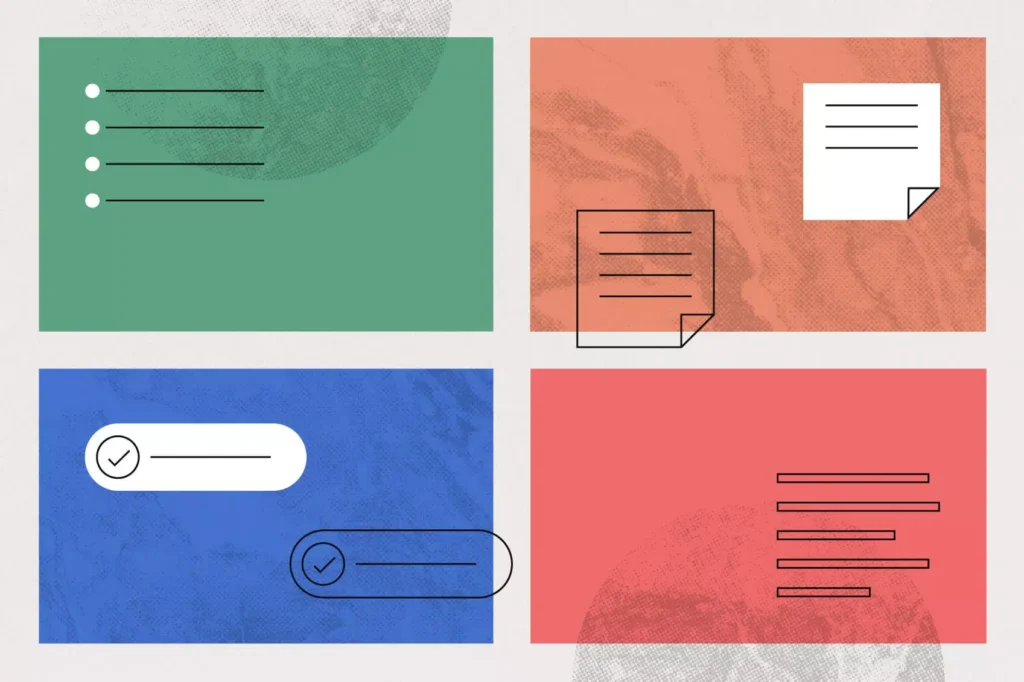
Tips on Further Sorting Tasks into Each Quadrant
After organizing your tasks into their respective category, you may still struggle to prioritize your tasks.
Here are some tips that can further help you prioritize different tasks into each quadrant:

Color Coding Your Tasks
For people who are visual learners, color-coding is a great way to see what tasks are of current importance.
As you go through your to-do list, try to assign colors based on the importance level of that task. You can use any color you want, but here are my suggestions:
Green = Highest Priority
Yellow = 2nd Highest
Blue = 3rd Highest
Red = Not a Priority
These colors will then directly match up with the Eisenhower Matrix diagram from the image above. The green quadrant represents the “do” tasks; the yellow quadrant represents the “schedule” tasks; the blue quadrant represents the “delegate” tasks, and the red quadrant represents the “delete” tasks.
Limit Tasks to 10 Per Quadrant
Try your best to limit each quadrant to 10 tasks. Even if you have more than that on your to-do list, choose the most important 10.
This ensures your matrices are not too cluttered and you can begin working on these tasks right away without wasting any time.
Separate Personal and Professional To-Do Lists
If you had trouble trying to limit the tasks to 10 per quadrant, another option is to create a separate list and matrix. For example, your personal goals could have one matrix, and your business-related tasks would go in a different matrix.
Personal and business-related tasks have different goals, timelines, and methods, likely requiring different aspects as well.
To effectively manage all your tasks, you need to divide and conquer.
Eliminate First Before Prioritizing
Sometimes, finding a task to prioritize first can be difficult. Instead, try working backwards. In other words, start looking for tasks you can eliminate first.
As you skim through the list, look for tasks that aren’t necessarily needed and can be removed for the time being. This ensures that you can efficiently create the matrix without overthinking.
A study by Asana shows that 60% of a person’s time spent at work is about work, things like status approvals or following up. If you can quickly scratch off a task, do so right away.
This will drastically decrease the time you spend prioritizing tasks and lower the chances that you will need a second round of elimination.
Mastering Productivity With the Pareto Principle

None of the previous methods worked? Try this one!
In blogging, many people refer to something called the Pareto Principle. While not directly related to productivity, once you understand the concept, it will indirectly help improve that skill.
Originally, the Pareto Principle referred to the observation that 80% of Italy’s wealth belonged to 20% of the population.
In modern day, it is now generally referring to the fact that not all things in life are distributed evenly.
Essentially, the concept is that 20% of the work you put in will yield 80% of the results.
There is a common misconception that these percentages should add up to 100.
They don’t.
Think about it, in a normal workplace, if there are 100 workers, but only 20 do the assignment, then 20% of the workers did 100% of the work.
This principle is only a rough guide to follow. The main concept is that not all tasks require the same amount of effort – some contribute more than others.
Most things in life aren’t of equal value. Maybe in a utopian society it could, but perfection is never guaranteed.
Out of 5 things in life, maybe one thing will be “cool”. That cool thing/idea/person will contribute to the majority of the impact, illustrating the 20/80 rule.
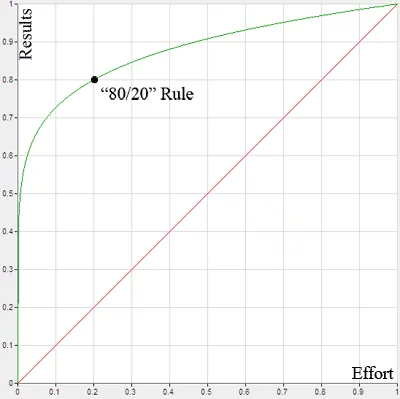
Graph Illustrating the Pareto Principle
As shown in the graph above, the green line would represent the Pareto Principle, encompassing the majority of the impact of that one cool thing/idea/person. The red line is what we’d like life to be: everything has equal value and distribution.
Of course, this ratio is not set in stone. Like I stated before, this principle is just a rough guide or estimate. It could be 30/50, or 10/90. It will vary based on the situation.
Knowing this, you can apply this concept to a variety of scenarios. These are just some examples:
- 20% of workers contribute to 80% of results: Focus on rewarding these employees first
- 20% of products contribute to 80% of revenue: Focus on marketing those products more
- 20% of your assignments contribute to 80% of your grade: Focus on doing those assignments.
In economic terms, it’s called a diminishing marginal benefit.
Related to the law of diminishing returns, for each hour of additional effort, you are decreasing the quality of the result. By the end, you are spending so much time scrutinizing the minor details that you forget to look at the bigger picture.
A Real Life Example
Everything said above is what is assumed based on an IDEAL situation. In life, however, nothing is ideal, and there will always be roadblocks. Here I have a video of someone drawing a car with Microsoft Paint. Though a simple tool, it’s quite fascinating how something as basic as this can create such an intricate drawing.
Now let’s break down the video. The video is 5 minutes long, with 1 minute for each section. This means each section is around 20% of the way to completion. Here are some pictures of how the car evolved:





Now let’s say this person was a designer, creating potential cars for his clients. He could present one of 3 scenarios:
- One top-quality car (Level 5)
- A semi-decent car (Level 3) and colorized wire frame (Level 2)
- 5 cars at the wireframe level (Level 1)
Now you might be thinking, isn’t the Level 5 car inevitably better than all the options?
Yes. That’s true. But, the point of this is not the quality of the car, its what yields the most efficient results.
Remember that this is a designer drafting various car designs for a client. As such, this designer should provide various options to show the versatility of his craft. If the client isn’t satisfied with one design, he can have multiple designs to choose from.
Whether they are top quality or not doesn’t matter at this point; the client knows that the designer can get it done, but just needs a concept sketch of what it may look like.
Alternatively, if the client doesn’t know what he/she want, having more design choices can improve your service. They can pick and choose what they like, and give a general direction or advice to the designer on what they might prefer.
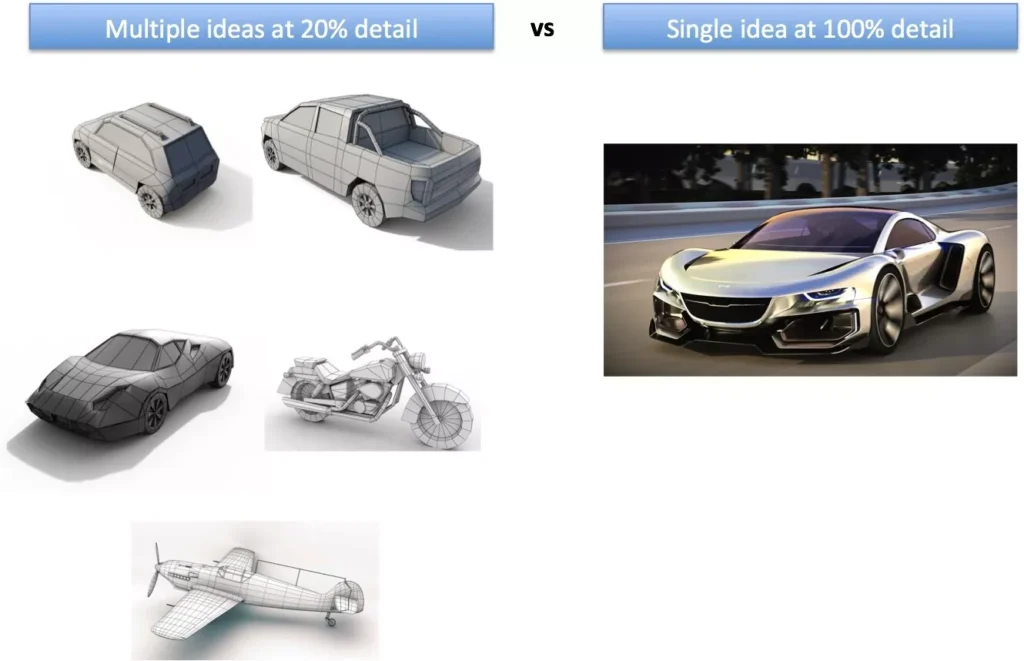
In this case, quantity matters more than quality. We’re looking for what gives us more bang for our buck. In the planning stage, we don’t need to put in 100% effort as our client hasn’t made a decision yet. Consequently, it may be faster to get 5 prototypes running rather than spending time perfecting 1.
In the video, after 1 minute (20%), we can already see the basic outline of the car. Everything after only adds details such as color and shape.
While there are changes as the video progresses, the majority of the work is done in the first minute. Each detail does add more meaning and depth to the image, but they don’t compare to the detail that the first image does upfront.
This clearly illustrates the Pareto Principle as the first minute already contributed around 80% of the 20% effort (1 minute) the person put in.
In Conclusion…
Improving productivity in high school isn’t about working nonstop. It’s about balancing your tasks, setting realistic goals, and taking care of yourself mentally and physically.
A simple calendar, some well-placed goals, and a focus on your journey can help keep you on track. So, don’t stress too much—take breaks, socialize, and remember to stay true to yourself.
Need more info? Sign up for our newsletter!

The most of thing is being truely yourself.
Thank you for your kind words!
This is a positive experience you have summarized in this stage and it is how it should be done to achieve good academy. Thanks for sharing study tips. I am envisioning you a success in the future.
Thank you so much for your comment! I will be posting more tips and tricks in the coming weeks.